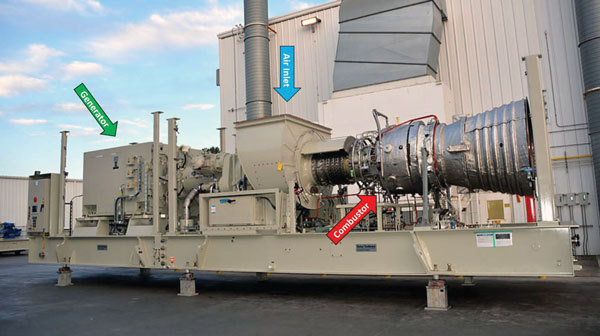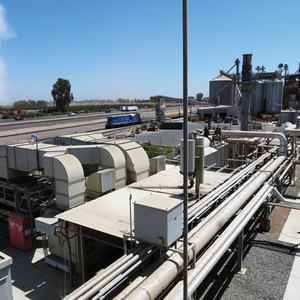Off The Grid



PHOTO: CALGREN RENEWABLE FUELS
September 17, 2019
BY Matt Thompson
Conversations about how to squeeze more value out of ethanol plants often focus on corn fiber-to-ethanol systems and production of high-protein coproducts, or minimizing input costs like power and feedstocks. But as those types of improvements become more common, plants are looking to other areas to cut costs and increase revenue, says Bernie Hoffman, CEO of TotalGen Services, which specializes in combined-heat-and-power systems (CHP) for ethanol plants. “Most plants have picked off all of the low-hanging fruit with respect to upgrades,” he says. “People are looking at some pretty big commitments from a capital perspective to go to the next step.”
One potential next step is installing a CHP system. The systems generally burn natural gas, which powers a turbine that generates electricity. A heat recovery steam generator (HRSG) then uses excess heat from the turbine to produce the steam that’s used in the plant, and in many cases, allows a plant to discontinue use of its boilers. While the capital cost to install a CHP system can be substantial, so can the benefits.
“The real significant benefit is if you are in a geographic position to sell into California,” Hoffman says. He estimates plants, on average, see a carbon intensity (CI) score reduction of about nine points. “Of course, a nine-point CI reduction, if you’re selling to California, can be monetized pretty dramatically,” he says.
CHP, also called cogeneration, has been used successfully in industries such as paper and fertilizer, according to Hoffman. But it’s somewhat uncommon in ethanol, he says, estimating that 5 percent of U.S. dry mill ethanol plants use the system. A combination of low electricity costs when ethanol plants were first built, the challenge of raising enough equity to build, and the lack of a low-carbon incentive kept plants from initially considering CHP systems, he says.
While Hoffman says any plant can potentially benefit from CHP, plants in Nebraska have a difficult time installing systems. “There’s a lot of eligible plants in Nebraska that we really can’t look at because the state of Nebraska regs, in effect, prohibit you from doing that,” he says. “It’s not that simple, but they make it such that you wouldn’t do this.” He adds that CHP systems using biomass would be an option for Nebraska, but those systems add another level of complexity.
In Action
Poet uses CHP systems at several of its plants. “Our mission is to produce biofuels in an environmentally friendly way,” says Rod Pierson, senior vice president and general manager of Poet Design and Construction. “So definitely reducing CI is critical to that, because anytime you reduce CI, you’re better for the environment.” He adds that while the company does realize an energy savings, its main focus is on the environmental benefits of using the systems.
Pierson says Poet has used CHP systems for several years. Original installations included a natural gas-fired turbine. “The initial installations had a few challenges, but, essentially, we were able to hit the ground running with our first installation and have had very few major issues, only small issues,” Pierson says. The company has, more recently, also installed steam turbine generators, which produce electricity from high-pressure steam, allowing letdown steam to run the plant, Pierson explains.
These turbines, while similar to the natural gas-powered turbines, are not true CHP systems, according to Hoffman. “In the case of a letdown turbine, a small steam-driven turbine is installed in a step in the ethanol plant where process steam pressure is dropped from roughly 125 psi to atmospheric pressure,” he says. That pressure drop drives the turbine, which produces a small amount of electricity, generally less than would be provided by a CHP system with a natural gas-powered turbine and HRSG. “The gas-fired turbines used in CHP are larger and can provide all of the electricity needed by the host ethanol plant,” Hoffman says. “The waste heat recovery can provide most or all of the steam. This results in efficiencies at 90 percent or a little higher.”
Pierson agrees that while steam-powered turbines cost less to install, they are limited in the amount of power they can generate. He says Poet plans to continue using both CHP systems and steam turbines, and potentially expand their use to other plants. “We have a few additional potential projects identified and we’ll be looking for that along with any other opportunities,” he says. “We’re always looking for those opportunities to reduce CI and improve our production process to be more environmentally friendly.”
Savings and Revenue
Hoffman says TotalGen has modeled the data from about 20 U.S. ethanol plants. “Depending on the design of the plant, we cut their energy use by, on the low end, about 35 percent, and on the high end about 55 percent,” he says. “We’ve actually seen one that was about a 58 percent reduction in energy use, depending on the efficiency of the plant.” Hoffman’s estimates are in line with a 2007 U.S. EPA report that says the use of CHP in ethanol plants can reduce energy use by almost 55 percent.
That savings in energy results in an attractive return on investment. “It’s not the kind of thing people have seen in some of the low-hanging fruit type enhancements that pay out in a year or so,” Hoffman says. “But you’re talking about a three-year [ROI], plus or minus, just on energy savings.
“The key thing is that these things are highly efficient,” he adds. “What people probably don’t necessarily realize is that a lot of the traditional power that’s generated by the utilities is something in the neighborhood of 60 percent efficient because they condense steam either in cooling towers or into lakes and rivers. That heat is lost. In a turbine/HRSG configuration like we would propose for an ethanol plant, you’re recovering all of that waste heat. A typical CHP is something just above 90 percent efficient.”
CHP systems can also offer an additional source of revenue. The systems can be designed to generate more power than the plant uses, allowing the excess electricity to be sold back to the utility company or marketplace. While it is an option, Hoffman says it’s not common for ethanol plants. “What we have found is that the excess electricity sales will generate revenue, but it’s not a significant revenue generator.”
Pierson agrees. He says Poet has explored the option but has opted not to sell excess electricity. “Unfortunately, you don’t get paid very much to put electricity to the grid, so it’s just not attractive,” he says.
While it may be rare, Calgren Renewable Fuels in Pixley, California, does sell its excess electricity. Lyle Schlyer, Calgren’s president, says the plant’s CHP system was incorporated into the original design because of limitations of the local power grid. After adding a new turbine in 2016, the plant’s electrical generation capacity increased, allowing it to generate more power than it consumes. “We’re 11 megawatts and we only draw about 3.8 these days, and we sell a little bit to a carbon dioxide plant, but the remainder goes back to the grid, about 5 megawatts,” he says.
However, he agrees it may not be attractive for every plant. He says Calgren’s Kansas plant doesn’t sell excess power. “It does not make sense to do it in Kansas,” he says, adding that the electricity market isn’t favorable.
Schlyer also backs up the efficiency claim about CHP turbines. “It allows us to run these units the way they were intended. These gas-fired turbines run way better when they’re running at or close to full load than they do when they’re running at half-speed.”
The other major benefit is being able to generate power and keep the plant running, even when the local utility isn’t able to. “I like the fact that when there’s a tornado or cyclone or earthquake in California, or wildfire or a tree limb takes out an electrical feeder, we just soldier on,” Schlyer says. “It’s a huge advantage.”
While Hoffman says one of the major advantages for plants in the Midwest to use CHP is a lower CI score, making low carbon markets more attractive, Schlyer says Calgren’s California plant doesn’t see that same benefit. “Midwest electricity, under the [Greenhouse Gases, Regulated Emissions, and Energy Use Transportation] model, is generated, to some extent, in coal-fired plants, and coal-fired plants end up creating a higher life cycle CI,” Schlyer says. “California’s a little cleaner because of its hydro.”
But, Schlyer says, the plant does benefit in electricity savings. “California electricity is through the roof,” he says.
“If you look at a typical ethanol plant’s electric bill, they pay X per megawatt hour for power,” Hoffman says. “But then they have all sorts of ancillary charges, and in some states, those can be pretty excessive.” Those charges for demand usage and time of use become a nonissue for plants that generate their own power. “You’re fundamentally paying a flat rate. At the end of the day, it’s indexed to natural gas, but it’s immune from all of those sorts of swings and charges.”
Both Pierson and Hoffman say cogeneration will increase in the ethanol industry. Hoffman says the carbon benefits of such systems make it perfect for the California market now, and any other carbon markets that open in the future. “Ontario’s the largest motor fuel market in Canada, and that would be a terrific market for a low-carbon fuel ethanol, if and when that market comes into being,” he says. “And Canada has indicated they are going to do that.” Additionally, markets in Washington, Oregon and the Northeastern U.S. would potentially offer incentives for low-carbon fuels as well, he says.
Author: Matt Thompson
Associate Editor, Ethanol Producer Magazine
701.738.4922
mthompson@bbiinternational.com
Advertisement
Advertisement
Related Stories
U.S. fuel ethanol capacity fell slightly in April, while biodiesel and renewable diesel capacity held steady, according to data released by the U.S. EIA on June 30. Feedstock consumption was down when compared to the previous month.
XCF Global Inc. on July 8 provided a production update on its flagship New Rise Reno facility, underscoring that the plant has successfully produced SAF, renewable diesel, and renewable naphtha during its initial ramp-up.
The USDA’s Risk Management Agency is implementing multiple changes to the Camelina pilot insurance program for the 2026 and succeeding crop years. The changes will expand coverage options and provide greater flexibility for producers.
EcoCeres Inc. has signed a multi-year agreement to supply British Airways with sustainable aviation fuel (SAF). The fuel will be produced from 100% waste-based biomass feedstock, such as used cooking oil (UCO).
SAF Magazine and the Commercial Aviation Alternative Fuels Initiative announced the preliminary agenda for the North American SAF Conference and Expo, being held Sept. 22-24 at the Minneapolis Convention Center in Minneapolis, Minnesota.
Upcoming Events










